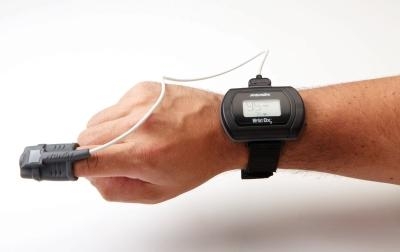Mon, Oct 14, 2013
Company Played A Role In F-22 Life Support System Task Force
The inventor of fingertip pulse oximetry said Thursday that 15 if its employees have received the United States Air Force Director's Award for their role in helping the Air Force return the F-22 Raptor, the world's most advanced fighter jet, to active service. The award, presented to Nonin Medical, was signed by Major General Charles Lyon, Air Combat Command Director of Operations, and by Colonel Gregory Gutterman, F-22 System Program Director.

The F-22 Raptor is a single-seat, twin-engine fifth-generation super maneuverable fighter aircraft that uses stealth technology. The Air Force grounded its F-22 fleet after reports that some Raptor pilots were experiencing temporary physiological symptoms that at the time were thought to be associated with low blood oxygen saturation.
"The Air Force chose Nonin pulse oximeters and sensors to help with its investigation because of our devices' ability to accurately and reliably measure oxygen saturation and pulse rate under extremely challenging conditions," said Mark VanderWerf, Vice-President of eHealth and OEM for Nonin Medical. "Nonin employees, including those in engineering, quality, technical service and marketing worked closely with the Air Force to ensure that our products exceeded their expectations for accuracy and reliability," VanderWerf said.

Nonin provided the Air Force with the WristOx2 Model 3150 wrist-worn pulse oximeter and the Model 8000J sensor. The Air Force mounted the 8000J sensor inside the pilots' helmets and the 3150 to the flight suit so they could monitor the pilots' blood oxygen saturation and pulse rate throughout the duration of each flight, but especially during strenuous F-22 maneuvers. The sensor sent the data back to the Nonin WristOx2 pulse oximeter, which displayed the data and stored it for later downloading and reporting. The data collected from pilots helped the Air Force rule out low blood oxygen saturation as a cause of pilot physiological symptoms. Investigators later determined that malfunctioning valves in the pressurized flight suits were un-necessarily restricting pilot breathing and causing the symptoms. The Air Force corrected the problem and returned its Raptor fleet to full operation earlier this year.
"Nonin Medical is proud to have played an important role in the F-22 Life Support System Task Force," said VanderWerf. "Our talented and dedicated employees helped the Air Force keep its pilots safe, return the Raptor to full mission capable status and restore confidence in the F-22 Raptor as the most technically advanced fighter jet employed to keep the United States secure."
(Image provided by Nonin Medical. F-22 image from file)
More News
Also: New SAF, Korean Air Buys 103 Boeings, Maryland SP Helo Rescue, OK AWOS Update Gulfstream Aerospace Corporation announced its first customer delivery of the all-new Gulfstream>[...]
"This is just an absolute win win win. If there is a rejected takeoff we now have the confidence that the arrestor system will ensure passenger and crew safety." Source: FAA Admini>[...]
Low Approach An approach over an airport or runway following an instrument approach or a VFR approach including the go-around maneuver where the pilot intentionally does not make c>[...]
Aero Linx: Historic Aircraft Association (HAA) The Historic Aircraft Association (HAA) was founded in 1979 with the aim of furthering the safe flying of historic aircraft in the UK>[...]
While Flying About 1,500 Ft Above Ground Level, A Large Bird Struck The Right Side Of The Airplane Analysis: The pilot reported that while flying about 1,500 ft above ground level,>[...]
 Airborne 08.29.25: G800 Delivery, Alaska F-35 Crash, USCG-RCAF Medevac
Airborne 08.29.25: G800 Delivery, Alaska F-35 Crash, USCG-RCAF Medevac Aero-News: Quote of the Day (08.30.25)
Aero-News: Quote of the Day (08.30.25) ANN's Daily Aero-Term (08.30.25): Low Approach
ANN's Daily Aero-Term (08.30.25): Low Approach ANN's Daily Aero-Linx (08.30.25)
ANN's Daily Aero-Linx (08.30.25) NTSB Final Report: Excalibur Excalibur
NTSB Final Report: Excalibur Excalibur




